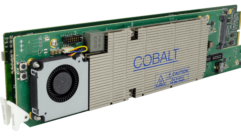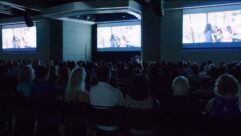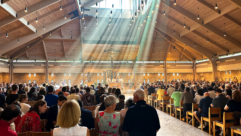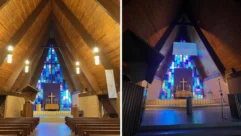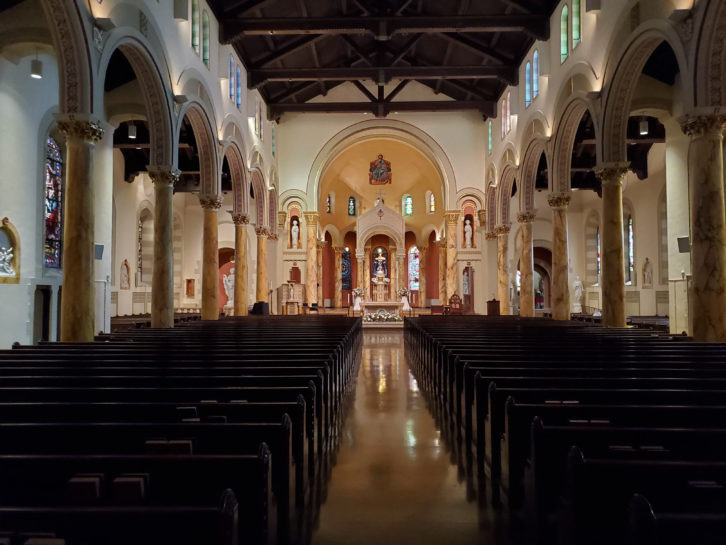 The largest Catholic churches were designed to have lofty reverberation but that can challenge the clarity of speech sound systems. St. Bartholomew’s Church in Elmhurst, New York is one of the biggest around, and the cathedral style church has a unique layout that made it even tougher. They called in Monte Brothers to overhaul their system and get the sound right. Steve Minozzi has that story for us.
The largest Catholic churches were designed to have lofty reverberation but that can challenge the clarity of speech sound systems. St. Bartholomew’s Church in Elmhurst, New York is one of the biggest around, and the cathedral style church has a unique layout that made it even tougher. They called in Monte Brothers to overhaul their system and get the sound right. Steve Minozzi has that story for us.
SVC: Welcome, thanks for being here. First can you fill us in on what has been going on at Monte Brothers lately?
Steve Minozzi: Well, as you know we just completed St. Bartholomew’s Church in Elmhurst. Elmhurst is in Queens, which is one of the boroughs of New York City and it’s in the diocese of Brooklyn. Brooklyn is famous for its big and beautiful churches that were built many, many years back. These churches provide extreme challenges acoustically because there’s nowhere to put treatment on the walls. As you can see from the photos, these are very ornate; almost like museums. So in order for people to hear the spoken word and have good, accurate replication of singing and liturgical music you need to have a sound system that can adapt to these challenging acoustical environments.
Yeah, that impressive sounding reverberation doesn’t always mix well with electronic sound reinforcement.
No. It’s great for the music program, but it’s tough on the spoken word. And, you know, when these churches were built, believe it or not, the Masses were in Latin. There was not a lot of participation in the sanctuary of a Catholic church. Everything was done with the priest’s back to the congregation and he was speaking in Latin. Maybe he gave a homily for about three or four minutes through a small PA system and whatever the congregants heard, they heard. What they didn’t, they didn’t. But the evolving of houses of worship and the liturgical development that’s occurred with the congregations’ involvement, you have people that are not even professional speakers now speaking at microphone locations in these challenging environments. That was not what the original church was designed to accommodate. Today the services are very highly speech-oriented and intelligibility-oriented. So that became a new requirement for buildings that were designed more for visual enhancement and musical reproduction. The only way to deal with these needs is through technology, which is what we do.
I would think that St. Bartholomew’s is fairly traditional with a pastor, choir and organ.
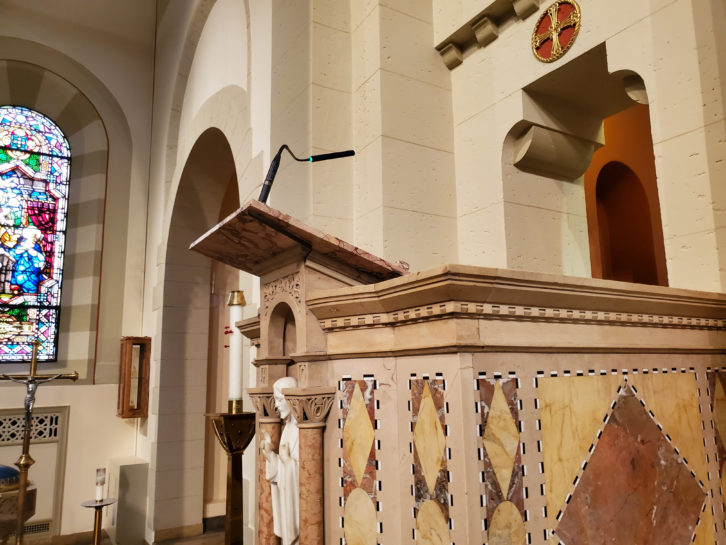 Yeah. Most denominations have choirs from the congregation. Not only do you have choirs, but as you can see from the floor plan, they have music programs that involve instrumentation, acoustic guitars, acoustic pianos. There are liturgical singing performances from not just the choir loft, but in the transepts on the left and right sides. There are multiple musical programs going on in that space at the same time besides the spoken word. This all has to pretty much happen automatically. In other words, the pastor of a church in no way can be manipulating a sound system. They don’t have sound engineers. These systems have to operate really in a user-friendly way.
Yeah. Most denominations have choirs from the congregation. Not only do you have choirs, but as you can see from the floor plan, they have music programs that involve instrumentation, acoustic guitars, acoustic pianos. There are liturgical singing performances from not just the choir loft, but in the transepts on the left and right sides. There are multiple musical programs going on in that space at the same time besides the spoken word. This all has to pretty much happen automatically. In other words, the pastor of a church in no way can be manipulating a sound system. They don’t have sound engineers. These systems have to operate really in a user-friendly way.
So it’s pretty much a turnkey system that you had to have in there that anybody can operate.
That’s correct. Pretty much we tell clients to leave it on. Don’t even turn it off because we have remote access to monitor the system and in case of emergency we can get in and we can find the problem from anywhere. We provide 24/7 service, because this is where the houses of worship are going.
What was it about the layout of St. Bartholomew’s church that made it especially challenging for speech clarity?
Well, the biggest challenge in this particular worship space was that the transepts are almost pseudo-transepts. The transept area is about 20 percent wider than the knave. That’s not typically the case in cruciform religious structures. Typically the transepts are much wider. In this case it’s almost like you have a knave and then you have a wider knave. In order to get even sound in all of the areas you need to select speaker profiles that accommodate acoustics by distance. So in the transept we have to use a line array with a cylindrical waveform. In the knave area, we use a low Q speaker that has a different waveform. And then we have to be able to align these–time alignment by the speed of sound, and by amplitudes. We have to create independent zones for each of these banks of speakers so we can balance them out. Because if they’re not balanced you’re not going to understand what people are saying.
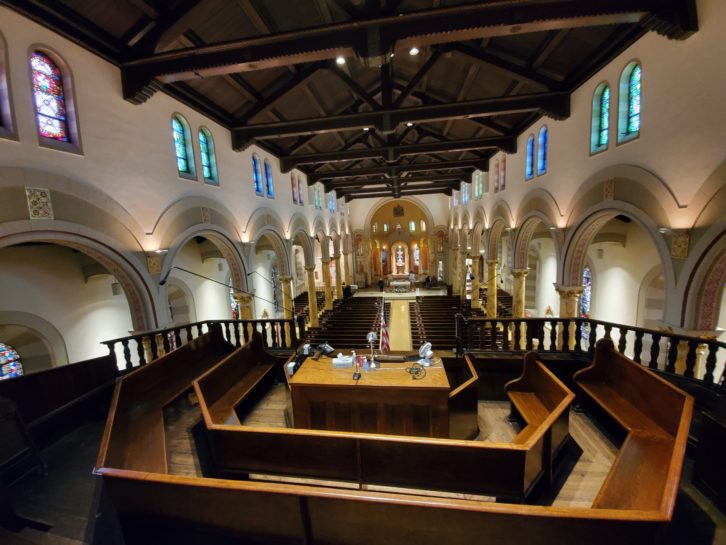 How did you come up with the control system to do that without making it too complicated for them to use?
How did you come up with the control system to do that without making it too complicated for them to use?
DSP. We were instrumental in working with Biamp and getting that into the marketplace 20 years ago when we agreed to field test it. We’ve been working with DSP processors–all the companies, many companies now. We use Biamp because we have a good relationship with them, but the other companies, they all have good products. The DSP processors now are in, I would say, generation four. They’re much more powerful. They have better technology. And so we have the ability to manage sound very, very acutely through our DSP processors. In this case there’s two—just for more horsepower and more ins and outs. That allows us to manage sound in the same way that you drive a car with an automatic transmission. It’s pretty simple. You put it in drive and you step on the gas; and then the brake, hopefully, when you want to stop. St. Bartholomew’s has an automatic sound system like an automatic transmission in a car. So it does a lot of things automatically. Dynamic range, it has low frequency management, it has all kinds of things going on that the owner doesn’t have to be aware of or doesn’t have to understand.
I noticed that on this project you used the Powersoft Quattrocanali 1204 amps. What was the advantage on those?
Well, with amplifiers you have to have dependability. That’s number one. And with Powersoft, we have direct access to the people in the company. In the field, we have certain situations that come up where we need assistance. It’s immediate. Their product is extremely reliable, and it has a lot of features that accommodate us. For example, we don’t use impedance-matching transformers a lot, but in some cases we do. For instance a cry room in a worship space where we are just using basic speakers or outside speakers that can use impedance-matching transformers, the Powersoft will automatically detect that and accommodate that. That’s a big feature for contractors. It eliminates the need to go and use an impedance-matching transformer interface on the amplifier, which is another piece of equipment. I would say dependability and flexibility are the two reasons that the Powersoft amplifier is in our repertoire of equipment.
Of course this is a huge place and a big project. When you put all of this in, did you have to run all new wiring for the speaker system?
Absolutely, yeah. We always run the wire because all of the zones have to be independently wired. We do run foil-shielded, plenum-rated speaker cable even. I know companies tell you don’t do that. You don’t need to do it. We do it. We’ve been doing it for 20 years and we’re going to continue to do it. It’s more expensive and the owners understand that. We’re in business 50 years this year, 2019. We’ve done upgrades for sound systems that we put in 25 years ago and we’re still able to use the speaker cable we put in—though of course we usually have to add more because the designs change.
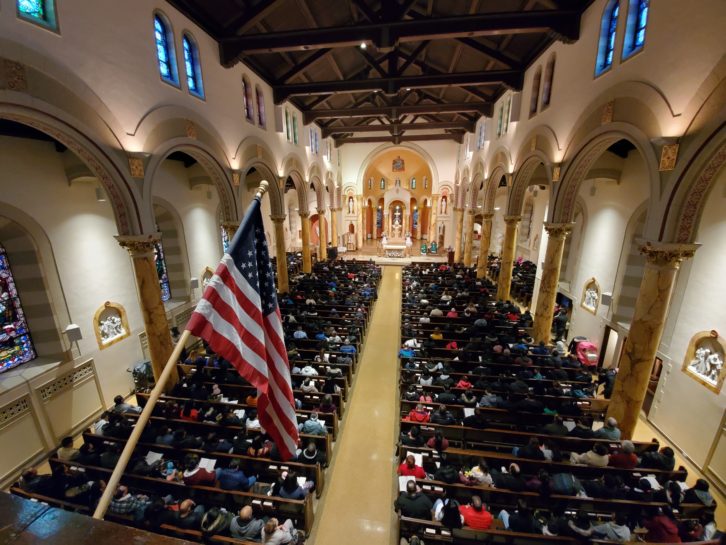 It’s a great thing to do because the speaker wiring would be one of the toughest and most time-consuming components to update.
It’s a great thing to do because the speaker wiring would be one of the toughest and most time-consuming components to update.
It is. Absolutely. And if you try to use the cable that’s there, even if it looks like it’s okay, you don’t know if they made splices, if they did them incorrectly, or where they made them. You don’t know the integrity of the cable. So therefore we know and we have all the records. If our client calls and says, “This is St. Bartholomew’s Church,” we type in their telephone number and we’ve got everything. We’ve got the type of cable we used, how we did it, where it’s run, what it does. We use Belden microphone cable, the highest quality. We use multicable for all these projects. It has to be all-new unless it’s something we did 20 years ago and we know that it hasn’t been compromised. Of course we test it anyway, but that’s the investment that the owner makes in getting a system from Monte Brothers. It’s designed to last.
I believe you used the CAMM line of speakers, several different models.
Right. I believe they’re owned by Leon now, but it’s still the CAMM and we also used Terra on outside sound. The reason we use the CAMM is we helped develop that Ferrofluid technology where the voice floats on electromagnetic Ferrofluid. Back in 1999, it was originally called NEAR–New England Audio Resource. So we’ve been working with these people for 20 years. Basically the importance with speakers is that – two things. In a house of worship they have to cosmetically acceptable to the owner. CAMM will actually screen the grill cloths and make them any color you want. And of course it has to have a good sound. There are many good speaker companies. I mean it’s like BMW, Mercedes, Cadillac. It’s just this is another step in the direction of cosmetics. That’s pretty much why we stay with them. And we do have a voice about discontinuation. Before they drop a speaker line, we need to know because if any of these speakers are discontinued in five years and there’s water or electrical storm damage, how do we replace them? We would have to change all of the speakers that were that model. That’s an extreme cost to the owner. I think that would be a very unpleasant experience for the owner. So that’s another reason why we use that company. They can give us the attention we need to deal with spaces that look like this space, which are very cosmetically challenging.
St. Bartholomew’s is so huge. Does it sound a lot different when you have it full of people than it does when it’s empty?
Yes. And it does not have pew cushions, which we highly recommend in houses of worship. But that’s a political issue and that’s for another day. So typically a worship space like this, would probably have about 4,000-4,500 square feet of absorption in it. In essence it has none. No absorption. The only asset it has going for it is the ceiling is a little lower on the side aisles of the nave. That helps somewhat. But yes, what happens in that church is the acoustic profile changes by almost 70 percent from completely empty to completely full. When you have pew cushions or upholstered pews, it only changes about 20-25 percent. That being said, how do we deal with it? Well, that’s where the DSP processor comes in. It creates a dynamic range and we have ways of programming those processes. Because we can’t do it with absorption. There’s nowhere to put the absorption. So that makes these churches more difficult than buildings.
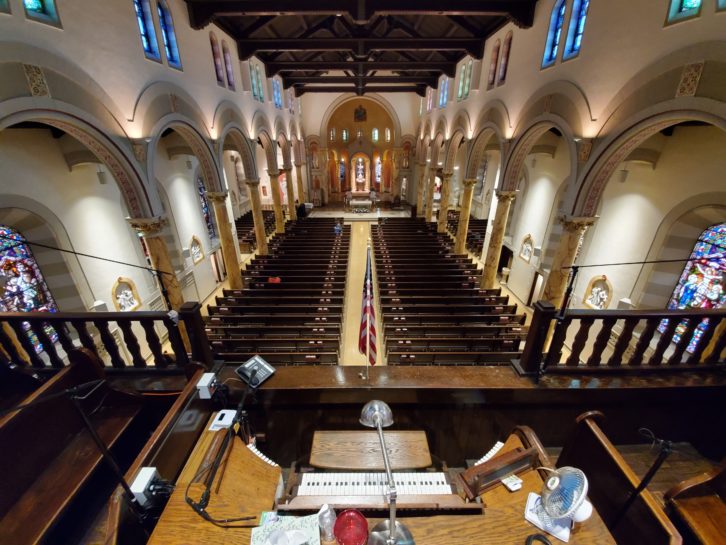 The choir appears to be located way back up in the rear balcony. How do they hear the pastor and the organ?
The choir appears to be located way back up in the rear balcony. How do they hear the pastor and the organ?
The speakers in the choir loft are like having a separate sound system. Those speakers only amplify the microphones in the sanctuary or microphones that are not in the choir loft. Therefore you don’t get phase cancellation and acoustic feedback from microphones coming out of speakers that are in their vicinity.
OK, sort of a mix-minus arrangement.
It is, yes. But, again, it’s done automatically. And then of course if you have people performing in the left transept, that microphone doesn’t necessarily get replicated from the speaker that’s right next to it. If you’re going through the right transept that microphone is not amplified by the speaker that’s next to it because you don’t need it and it’s going to create a problem. But that’s all automatic. It’s done by the management for the DSP processors. I don’t know how else you would do it. You’d have to have a full-time engineer and if he got sick what would you have for the service?
How did you balance levels and test everything?
We have to balance it under the worst-case scenario, which his empty. Then, as we said, there’s a 70 percent change in acoustics during services. So after the system is in, we have a technician attend the weekend services with a computer. And he literally recalibrates whatever has to be done with the attendance there, and depending on the different levels of attendance on weekends. Some services only get a quarter full, some get full, and we’re able to calibrate the system under those conditions.
Is there a specific frequency range that you find in these layouts that’s most prone to feedback?
Well feedback, that depends on what mics you’re using, what speakers you’re using, where the mics are in relation to the speakers. The feedback cycles typically are affected by that. Worship spaces that look like this, typically have very, very active acoustics in the mid-range and low frequencies; so from, say, 180 Hz to about 800 Hz we have a lot of activity. And that absolutely affects intelligibility.
So what’s coming up next for Monte Brothers?
Well, we have a lot of projects. We are doing one in Virginia that’s incredibly challenging and I think you would be very impressed with the size, the logistics. It’s not a traditional space, it’s a more modern space. But it has acoustics that are actually more challenging even than St. Bartholomew in Elmhurst.



